| Listing 1 - 10 of 22 | << page >> |
Sort by
|
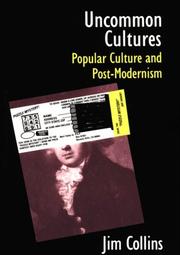
ISBN: 0415901375 0415900166 9780415900164 9780415901376 Year: 1989 Publisher: London: Routledge,
Abstract | Keywords | Export | Availability | Bookmark
 Loading...
Loading...Choose an application
- Reference Manager
- EndNote
- RefWorks (Direct export to RefWorks)
Comparative literature --- Sociology of culture --- anno 1900-1999 --- Popular culture --- Postmodernism --- Culture populaire --- Postmodernisme --- Postmodernism. --- Popular culture. --- 82.015.9 --- 316.728 --- 316.323.9 --- 316.728.1 --- #SBIB:309H040 --- #SBIB:316.7C170 --- Post-modernism --- Postmodernism (Philosophy) --- Arts, Modern --- Avant-garde (Aesthetics) --- Modernism (Art) --- Philosophy, Modern --- Post-postmodernism --- Culture, Popular --- Mass culture --- Pop culture --- Popular arts --- Communication --- Intellectual life --- Mass society --- Recreation --- Literaire stromingen: postmodernisme --- Cultuur. Levenswijze --- Postmoderne maatschappij. Sociologie van het postmodernisme --- Popculture. Popular culture. Volkscultuur. --- Populaire cultuur algemeen --- Cultuursociologie: culturele groei, vooruitgang, stagnatie, technologische verandering, cultuurbewegingen --- 316.728.1 Popculture. Popular culture. Volkscultuur. --- 316.323.9 Postmoderne maatschappij. Sociologie van het postmodernisme --- 316.728 Cultuur. Levenswijze --- 82.015.9 Literaire stromingen: postmodernisme --- Culture --- Popculture. Popular culture. Volkscultuur
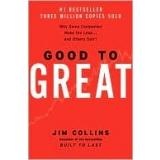
ISBN: 0066620996 9780066620992 Year: 2001 Publisher: Glasgow: HarperCollins,
Abstract | Keywords | Export | Availability | Bookmark
 Loading...
Loading...Choose an application
- Reference Manager
- EndNote
- RefWorks (Direct export to RefWorks)
The Challenge Built to Last, the defining management study of the nineties, showed how great companies triumph over time and how long-term sustained performance can be engineered into the DNA of an enterprise from the verybeginning. But what about the company that is not born with great DNA? How can good companies, mediocre companies, even bad companies achieve enduring greatness? The Study For years, this question preyed on the mind of Jim Collins. Are there companies that defy gravity and convert long-term mediocrity or worse into long-term superiority? And if so, what are the universal distinguishing characteristics that cause a company to go from good to great? The Standards Using tough benchmarks, Collins and his research team identified a set of elite companies that made the leap to great results and sustained those results for at least fifteen years. How great? After the leap, the good-to-great companies generated cumulative stock returns that beat the general stock market by an average of seven times in fifteen years, better than twice the results delivered by a composite index of the world's greatest companies, including Coca-Cola, Intel, General Electric, and Merck. The Comparisons The research team contrasted the good-to-great companies with a carefully selected set of comparison companies that failed to make the leap from good to great. What was different? Why did one set of companies become truly great performers while the other set remained only good? Over five years, the team analyzed the histories of all twenty-eight companies in the study. After sifting through mountains of data and thousands of pages of interviews, Collins and his crew discovered the key determinants of greatness — why some companies make the leap and others don't. The Findings The findings of the Good to Great study will surprise many readers.
Business management --- management --- bedrijfsbeleid --- Leadership. --- Strategic planning. --- Organizational change. --- Technological innovations --- Leadership --- Planification stratégique --- Changement organisationnel --- Innovations --- Management. --- Gestion --- Leadership Leadership --- Changement Verandering --- Performance Prestatie --- Organisation Organisatie --- Management Management --- Technologie Technologie --- Compétences Bevoegdheden --- 65.012.4 --- 658 --- bedrijfsreorganisatie --- bedrijfsstrategie --- entrepreneurship --- technologie --- Management. Directorate. Technique and methods of management --- Business management, administration. Commercial organization --- 658 Business management, administration. Commercial organization --- 65.012.4 Management. Directorate. Technique and methods of management --- Organisaties ; management. --- 334.7 --- Bedrijfsorganisatie ; management --- Economie ; organisatievormen en samenwerkingsverbanden, coöperaties --- Planification stratégique --- Organizational change --- Strategic planning --- Goal setting (Strategic planning) --- Planning, Strategic --- Strategic intent (Strategic planning) --- Strategic management --- Planning --- Business planning --- Change, Organizational --- Organization development --- Organizational development --- Organizational innovation --- Management --- Organization --- Manpower planning --- Ability --- Command of troops --- Followership --- Innovations technologiques --- Gestion. --- 658 Zaakvoering, administrat --- Zaakvoering, administrat --- Innovation

ISBN: 0415907063 9780415907064 0415907055 Year: 1995 Publisher: New York, N.Y. Routledge
Abstract | Keywords | Export | Availability | Bookmark
 Loading...
Loading...Choose an application
- Reference Manager
- EndNote
- RefWorks (Direct export to RefWorks)
Art --- Philosophy and psychology of culture --- 82:3 --- Literatuur en maatschappijwetenschappen --- Popular culture. --- Postmodernism. --- Technology and the arts. --- 82:3 Literatuur en maatschappijwetenschappen --- Popular culture --- Postmodernism --- Technology and the arts --- Arts and technology --- Arts --- Post-modernism --- Postmodernism (Philosophy) --- Arts, Modern --- Avant-garde (Aesthetics) --- Modernism (Art) --- Philosophy, Modern --- Post-postmodernism --- Culture, Popular --- Mass culture --- Pop culture --- Popular arts --- Communication --- Intellectual life --- Mass society --- Recreation --- Culture
Book
ISBN: 9780822345886 0822345889 9780822346067 0822346060 9786613036353 082239197X 1283036355 9781283036351 9780822391975 9781478092018 Year: 2010 Publisher: Durham, NC : Duke University Press,
Abstract | Keywords | Export | Availability | Bookmark
 Loading...
Loading...Choose an application
- Reference Manager
- EndNote
- RefWorks (Direct export to RefWorks)
A look at how technology and literary, visual, and consumer cultures have combined over the past two decades to transform a once solitary, print-based experience into an exuberantly social activity.
Sociology of cultural policy --- Literature --- reading culture --- e-books --- populaire cultuur --- geletterdheid --- leesgedrag --- lezen --- leesbevordering --- cultuurconsumptie --- boeken --- United States --- Book clubs (Bookselling) --- Book clubs (Discussion groups) --- Popular culture and literature --- Popular culture --- 82:3 --- Literature and popular culture --- Book clubs --- Book discussion groups --- Book study groups --- Clubs --- Group reading --- Booksellers and bookselling --- 82:3 Literatuur en maatschappijwetenschappen --- Literatuur en maatschappijwetenschappen --- Popular culture and literature - United States --- Popular culture - United States --- Book clubs (Bookselling) - United States --- Book clubs (Discussion groups) - United States --- United States of America
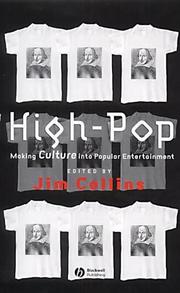
ISBN: 0631222111 0631222103 Year: 2002 Publisher: Oxford Blackwell
Abstract | Keywords | Export | Availability | Bookmark
 Loading...
Loading...Choose an application
- Reference Manager
- EndNote
- RefWorks (Direct export to RefWorks)
Popular culture --- Aesthetics --- -Arts and society --- -Mass media --- -Amusements --- -National characteristics, American --- #SBIB:309H040 --- #SBIB:316.7C140 --- American national characteristics --- Children --- Entertainments --- Pastimes --- Recreations --- Entertaining --- Games --- Play --- Recreation --- Mass communication --- Media, Mass --- Media, The --- Communication --- Arts --- Arts and sociology --- Society and the arts --- Sociology and the arts --- Beautiful, The --- Beauty --- Esthetics --- Taste (Aesthetics) --- Philosophy --- Art --- Criticism --- Literature --- Proportion --- Symmetry --- Social aspects --- -Social aspects --- -Populaire cultuur algemeen --- Cultuursociologie: cultuur en globale samenlevingen --- Psychology --- United States --- Civilization --- -Aesthetics --- Amusements --- Arts and society --- Mass media --- National characteristics, American. --- -Popular culture --- U.S.A. --- Jungtinės Amerikos valstybės --- Soedinennye Shtaty Si︠e︡vernoĭ Ameriki --- Soedinennye Shtaty Severnoĭ Ameriki --- Si︠e︡vero-Amerikanskīe Soedinennye Shtaty --- Severo-Amerikanskie Soedinennye Shtaty --- Zlucheni Derz︠h︡avy --- USA --- US --- Arhab --- Ar. ha-B. --- Artsot ha-Berit --- ولايات المتحدة الامريكية --- Wilāyāt al-Muttaḥidah al-Amirīkīyah --- ABSh --- Amerika Birlăshmish Shtatlary --- ABŞ --- Amerika Birlăşmi Ştatları --- Forente stater --- Spojené staty americké --- Severo-Amerikanskie Shtaty --- Sjedinjene Američke Države --- Zʹi︠e︡dnani Derz︠h︡avy Ameryky --- Amerikai Egyesült Államok --- Yhdysvallat --- Verenigde Staten --- Egyesült Államok --- Hiwsisayin Amerikayi Miatsʻeal Tērutʻiwnkʻ --- Estados Unidos de América --- United States of America --- Fareyniḳṭe Shṭaṭn --- Artzois Ha'bris --- Estados Unidos da América do Norte --- SShA --- Soedinennye Shtaty Ameriki --- VSA --- États-Unis d'Amérique --- Vereinigte Staaten von Amerika --- Stati Uniti d'America --- Estados Unidos --- EE.UU. --- Stany Zjednoczone --- ĒPA --- Amerika Qūrama Shtattary --- Amerika Qŭshma Shtatlari --- SAD --- Saharat ʻAmērikā --- Hēnomenai Politeiai Amerikēs --- ZSA --- Mei-kuo --- Meiguo --- Mei guo --- ZDA --- Združene države Amerike --- U.S. --- America (Republic) --- Amirika Carékat --- Verenigde State van Amerika --- VS --- ولايات المتحدة --- Wilāyāt al-Muttaḥidah --- ولايات المتّحدة الأمريكيّة --- Wilāyāt al-Muttaḥidah al-Amrīkīyah --- Estatos Unitos --- Estatos Unitos d'America --- Ètats-Unis d'Amèrica --- Estaos Xuníos d'América --- Estaos Xuníos --- Tetã peteĩ reko Amérikagua --- Istadus Unidus --- Amerika Birlăşmiş Ştatları --- Amerika ka Kelenyalen Jamanaw --- Bí-kok --- Amerika Qushma Shtattary --- AQSh --- Злучаныя Штаты Амерыкі --- Zluchanyi︠a︡ Shtaty Ameryki --- Yunaeted Stet blong Amerika --- Yunaeted Stet --- Vaeinigte Staatn --- Vaeinigte Staatn vo Amerika --- Stadoù-Unanet Amerika --- Sŭedineni amerikanski shtati --- САЩ --- SASht --- Съединените щати --- Sŭedinenite shtati --- Америка (Republic) --- Amerika (Republic) --- Estats Units d'Amèrica --- Америкӑри Пӗрлешӳллӗ Штатсем --- Amerikări Pĕrleshu̇llĕ Shtatsem --- Stati Uniti --- SUA (Stati Uniti d'America) --- Unol Daleithiau America --- Unol Daleithiau --- Amerikas Forenede Stater --- Vereinigte Staaten --- Wááshindoon Bikéyah Ałhidadiidzooígíí --- Zjadnośone staty Ameriki --- Ameerika Ühendriigid --- Ηνωμένες Πολιτείες της Αμερικής --- Hēnōmenes Politeies tēs Amerikēs --- Η.Π.Α. --- Ē.P.A. --- Usono --- Unuiĝintaj Ŝtatoj de Ameriko --- Американь Вейтьсэндявкс Штаттнэ --- Amerikanʹ Veĭtʹsėndi︠a︡vks Shtattnė --- Ameriketako Estatu Batuak --- Feriene Steaten --- Feriene Steaten fan Amearika --- FS --- Stâts Unîts di Americhe --- Stâts Unîts --- Stáit Aontaithe Mheiriceá --- Steatyn Unnaneysit America --- Steatyn Unnaneysit --- S.U.A. --- Na Stàitean Aonaichte --- NSA --- Mî-koet --- 미국 --- Miguk --- Amerikayi Miatsʻyal Nahangner --- Miatsʻyal Nahangner --- National characteristics, American --- Populaire cultuur algemeen --- Radio broadcasting Aesthetics
Book
ISBN: 9789047014942 Year: 2021 Publisher: Amsterdam Business Contact
Abstract | Keywords | Export | Availability | Bookmark
 Loading...
Loading...Choose an application
- Reference Manager
- EndNote
- RefWorks (Direct export to RefWorks)
Het vliegwieleffect? van Jim Collins is een verdieping van een van de krachtige elementen uit de wereldwijde bestseller ?Good to Great?. Daarin beschrijft Jim Collins dat succesvolle bedrijven een reeks van essentiële stappen nemen die samen aanvoelen als een groot, zwaar vliegwiel. Het kost grote moeite om het draaiend te krijgen, maar als je volhoudt gaat het telkens een beetje sneller draaien en creëer je momentum. Dat is het moment van de doorbraak naar succes. Aan de hand van casussen en theorie lees je welke stappen ervoor zorgen dat je het vliegwiel van jouw organisatie herkent. Ook ontdek je welke elementen het sneller doen draaien en hoe je het draaiend houdt in verschuivende markten. ?Het vliegwieleffect? is onafhankelijk te lezen ? met dit boek maak je een vliegende start ? en door ?Good to Great? ernaast te lezen til je het naar een nog hoger niveau. https://www.businesscontact.nl/boek/het-vliegwieleffect/
Organization theory --- management --- organisatiestrategieën --- strategisch beleid --- Strategisch management --- Ondernemen --- Organisatieleer --- Succesverhaal --- Ondernemerschap --- Management --- Bedrijfsmanagement
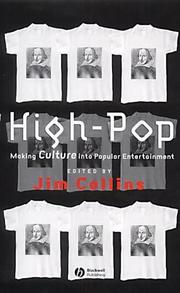
ISBN: 9780631222118 Year: 2002 Publisher: United Kingdom : Blackwell,
Abstract | Keywords | Export | Availability | Bookmark
 Loading...
Loading...Choose an application
- Reference Manager
- EndNote
- RefWorks (Direct export to RefWorks)
departement PHL Music 08 --- popmuziek --- muziek en cultuur
Book
ISBN: 1478092017 Year: 2010 Publisher: Durham : Duke University Press,
Abstract | Keywords | Export | Availability | Bookmark
 Loading...
Loading...Choose an application
- Reference Manager
- EndNote
- RefWorks (Direct export to RefWorks)
Bring on the Books for Everybody is an engaging assessmentof the robust popular literary culture that has developed in theUnited States during the past two decades. Jim Collins describeshow a once solitary and print-based experience has become anexuberantly social activity, enjoyed as much on the screen as onthe page. Fueled by Oprah's Book Club, Miramax film adaptations,superstore bookshops, and new technologies such as the Kindledigital reader, literary fiction has been transformed intobest-selling, high-concept entertainment. Collins highlights theinfrastructural and cultural changes that have given rise to aflourishing reading public at a time when the future of the bookhas been called into question. Book reading, he claims, has notbecome obsolete; it has become integrated into popular visualmedia. Collins explores how digital technologies and the convergence ofliterary, visual, and consumer cultures have changed what counts asa "literary experience" in phenomena ranging from lush filmadaptations such as The English Patient and Shakespeare in Love to the customer communities at Amazon.Central to Collins's analysis and, he argues, to contemporaryliterary culture, is the notion that refined taste is now easilyacquired; it is just a matter of knowing where to access it andwhose advice to trust. Using recent novels, he shows that theredefined literary landscape has affected not just how books arebeing read, but also what sort of novels are being written forthese passionate readers. Collins connects literary bestsellersfrom The Jane Austen Book Club and Literacy andLonging in L.A. to Saturday and The Line of Beauty, highlighting their depictions of fictional worldsfilled with avid readers and their equations of reading with cultivated consumer taste.
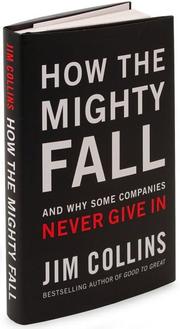
ISBN: 9780977326419 Year: 2009 Publisher: New York HarperCollins
Abstract | Keywords | Export | Availability | Bookmark
 Loading...
Loading...Choose an application
- Reference Manager
- EndNote
- RefWorks (Direct export to RefWorks)
Discusses signs pointing toward the decline of a business, how far the decline can proceed before failure becomes inevitable, and crucial steps companies can take to reverse course.
Business failures --- Management --- Organizational change --- Success in business
Book
ISBN: 0062119095 Year: 2005 Publisher: New York : HarperCollins Publishers,
Abstract | Keywords | Export | Availability | Bookmark
 Loading...
Loading...Choose an application
- Reference Manager
- EndNote
- RefWorks (Direct export to RefWorks)
Leadership. --- Executive ability. --- Strategic planning. --- Organizational change. --- Technological innovations --- Management.
| Listing 1 - 10 of 22 | << page >> |
Sort by
|

 Search
Search Feedback
Feedback About UniCat
About UniCat  Help
Help News
News